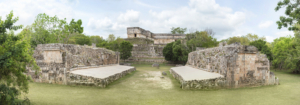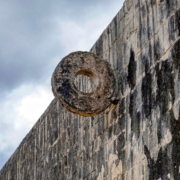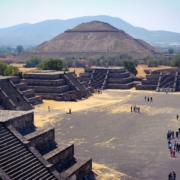Chichén Itzá is an archaeological site frequented by millions of visitors every year. It boasts an intriguing history, whispering stories of people long since passed. This site is one of the New Seven Wonders of the World, selected in 2007 for its cultural and historical significance.
When visiting the site, you’ll get to stroll along streets long since deserted by residents and look at depictions and monuments that allude to the stories of the past. As you make your way through the city, you’ll find the ball courts, a significant part of Mayan history. While much of its history has been lost to time, there are a few things historians have pieced together.
Understanding the History of Chichén Itzá
Chichén Itzá is an ancient city located on the Yucatan Peninsula of Mexico. It was an integral part of Mayan culture, serving as a sacred city founded by the Itzá. This Mayan group, known as water witches or water sorcerers, originated from Campeche or Tabasco.
The Itzá built the first buildings, which boasted Puuc’s artistic influence. They remained in power for about a century before their demise came at the hands of the rulers of Mayapan, once considered subordinate to them. The Mayapan defeated the Itzá, but eventually, they, too, found their downfall and were defeated by a confederation of cities headed by Uxmal.
While those cities overtook Chichén Itzá, its fame didn’t disappear into thin air. Instead, it remained a sacred, although abandoned, place for the Mayans. The Mayans continued to visit the deserted city for its cenote, making offerings and sacrifices here for centuries.
Centuries after its demise, the Spanish arrived on the coasts of Yucatan. The city was abandoned, and many of the people remaining in the area had scattered to rural regions.
Today, the site has been restored and is now a UNESCO World Heritage Site. it’s the second most visited archaeological site in Mexico, drawing countless tourists every year. The core area of the site is officially managed and protected by Mexico’s National Institute of Anthropology and History.
What Are the Ball Courts of Chichén Itzá?

The Chicén Itzá ball court is one of the largest in Mesoamerica. It stretches about 480 feet in length and about 120 feet in width, roughly the size of an American football field. It’s substantially larger than other ball courts, like the one at Uxmal, which are typically around the size of a tennis court.
There are tall vertical walls around the ball court. At this particular one, the walls are 27 feet high, with rings located 25 feet off the ground. These rings, where the ball would have gone through during a game, were adorned with intertwined feathered serpents. In most other ball courts, the sides are sloped and far lower.
The entire court, which forms the shape of the letter “I,” is flanked by temples on the southern and northern sides. The shape creates a unique acoustic phenomenon. If you were to speak in the temple at the southern end, your voice could be heard at the other end because the sound reverberates along the north temple’s walls.
The Mayan Ball Game: What We Know
Little is known about the specifics of the Mayan ball game. Like much of this area’s history, the details have been lost to time. What historians do know is that this game was a characteristic of Mesoamerican societies.
It was likely less of a sport, like those we know today, and more of a ceremonial ritual that embodied the mythical combat between light and dark or night and day. Held in the ball game court, it was more symbolic than entertainment.
Historians don’t know much about the rules of the game because the little they have is pictorial representations and stone monuments. From those representations, historians guess that the ball was tossed onto the court by hand, but after that moment, they suspect it could only be touched with the hips and thighs.
The number of players and scoring system are unknown. Based on information from the Popol Vuh, historians suppose the game may have been compatible with one-on-one players, pairs, or even teams.
The ball they played with was made from liquid latex from rubber trees. When heated, this latex became malleable and thread-like. Players rolled these threads or pressed them in a mold to form the ball. The final weight of the ball varied, and each player possessed his own ball. In some depictions, the balls were small enough to fit in the palm, but in others, they were larger than soccer balls.
Visit Chichén Itzá on a Guided Tour With Caravan
Whether you’re a history buff who appreciates the mysteries of years gone by or simply want to revel in the wonders of towering buildings that have stood for centuries, Chichén Itzá is well worth the visit. While much of its history remains shrouded by time, it’s still fascinating to walk through the streets that were once alive with the hustle and bustle of hundreds of people.
If you’re ready to visit Chichén Itzá (and more), our guided Mexico’s Ancient Civilizations tour might be the perfect fit. On this 9-day fully-guided tour, we bring you to some of the best archaeological spots in Mexico, including Chichén Itzá.
We explore Chichén Itzá, with its fascinating ball courts, Uxmal, with its intriguing pyramids, and Teotihuacan, once one of Mexico’s grandest cities. There’s so much to see and do here, but we make it easy on you by planning the entire trip for you.
We handle the details so that you can kick back, relax, and enjoy your vacation. You book your flights and arrive on time for the welcome briefing at the first hotel, and we’ll handle the rest. We’ve carefully selected comfortable lodgings, transportation, and restaurants to help you make the most of your trip (without planning on your part, of course).
So, if you’re ready to immerse yourself in the wonders of Mexico’s ancient civilizations, join us for a trip! Book a journey today by calling 1-800-CARAVAN or 1-312-321-9800.

